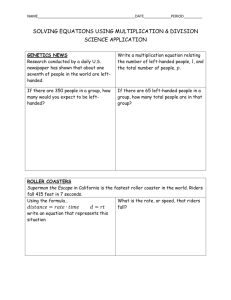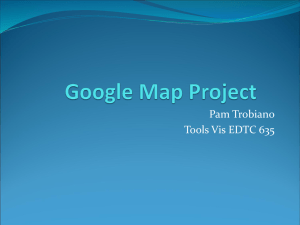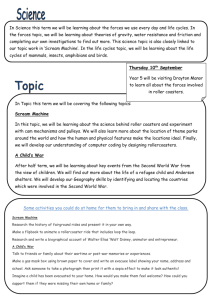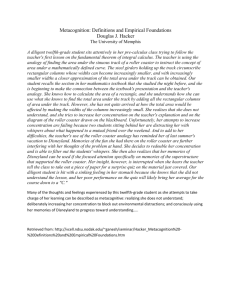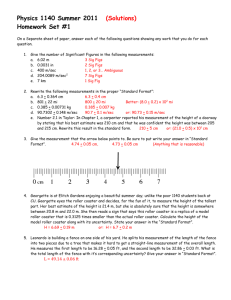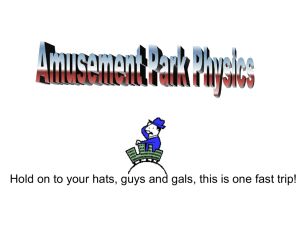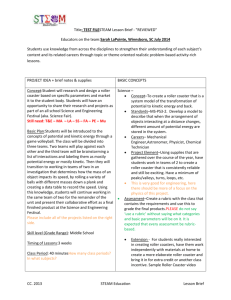English Language Arts - Massachusetts Department of Education
advertisement
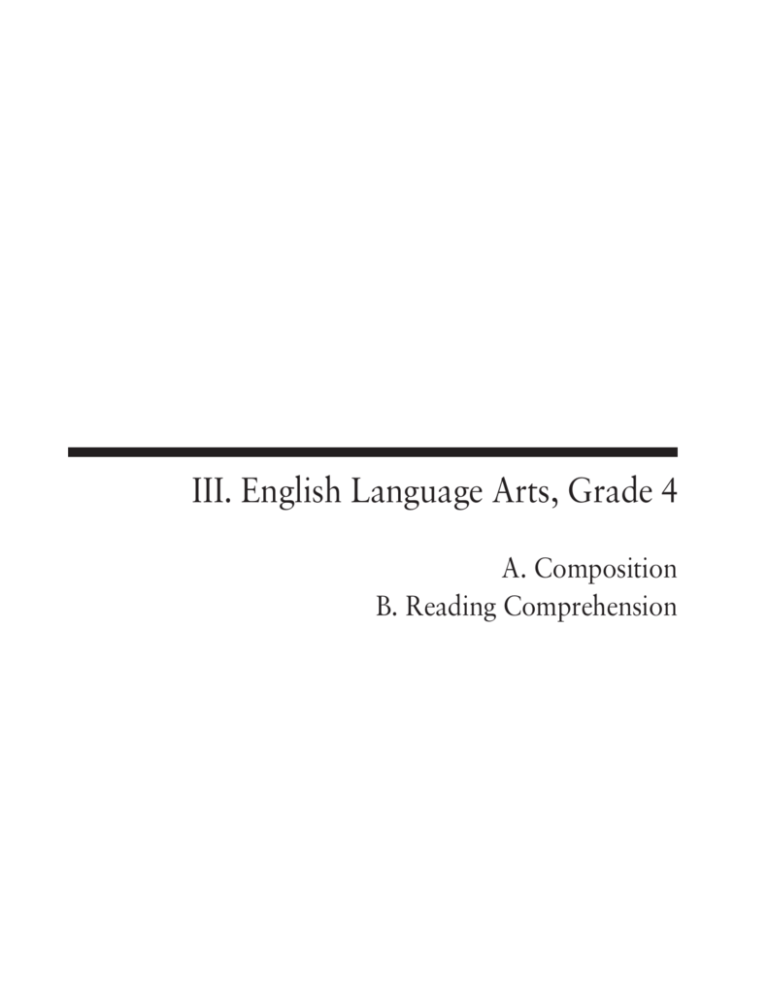
III. English Language Arts, Grade 4 A. Composition B. Reading Comprehension Grade 4 English Language Arts Test Test Structure The grade 4 MCAS English Language Arts test was presented in the following two parts: ■ the ELA Composition test, which used a writing prompt to assess learning standards from the Massachusetts English Language Arts Curriculum Framework’s Composition strand ■ the ELA Reading Comprehension test, which used multiple-choice and open-response questions to assess learning standards from the English Language Arts Curriculum Framework’s Language and Reading and Literature strands A. Composition The spring 2010 grade 4 MCAS English Language Arts Composition test and Composition Make-Up test were based on learning standards in the Composition strand of the Massachusetts English Language Arts Curriculum Framework (2001). The learning standards for the Composition strand appear on pages 72–83 of the Framework, which is available on the Department website at www.doe.mass.edu/ frameworks/current.html. In test item analysis reports and on the Subject Area Subscore pages of the MCAS School Reports and District Reports, ELA Composition test results are reported under the reporting categories Composition: Topic Development and Composition: Standard English Conventions. Test Sessions and Content Overview The MCAS ELA Composition test included two separate test sessions, administered on the same day with a short break between sessions. During the first session, each student wrote an initial draft of a composition in response to the appropriate writing prompt on the next two pages. During the second session, each student revised his or her draft and submitted a final composition, which was scored in the areas of Topic Development and Standard English Conventions. The Scoring Guides for the MCAS English Language Arts Composition are available at www.doe.mass.edu/mcas/student/elacomp_scoreguide.html. Reference Materials and Tools At least one English-language dictionary per classroom was provided for student use during ELA Composition test sessions. The use of bilingual dictionaries was allowed for current and former limited English proficient students only. No other reference materials or tools were allowed during either ELA Composition test session. Cross-Reference Information Framework general standards 19–22 are assessed by the ELA Composition. 21 English Language Arts Composition, Grade 4 Grade 4 Writing Prompt ID:281622 Embed Writing Prompt Think about a time when school was closed and you had the day off. Write a story about what you did on your day off from school. Give enough details in your story to show readers how you spent your day. You may use the space below to plan what you are going to write (notes, outlines, other pre-writing activities). 22 English Language Arts Composition, Grade 4 Grade 4 Make-Up Writing Prompt ID:281626 Embed Writing Prompt Write a story about a time when something funny or unusual happened. Give enough details in your story to show readers why the event was funny or unusual. You may use the space below to plan what you are going to write (notes, outlines, other pre-writing activities). 23 B. Reading Comprehension The spring 2010 grade 4 MCAS English Language Arts Reading Comprehension test was based on learning standards in the two content strands of the Massachusetts English Language Arts Curriculum Framework (2001) listed below. Page numbers for the learning standards appear in parentheses. ■Language (Framework, pages 19–26) ■Reading and Literature (Framework, pages 35–64) The English Language Arts Curriculum Framework is available on the Department website at www.doe.mass.edu/frameworks/current.html. In test item analysis reports and on the Subject Area Subscore pages of the MCAS School Reports and District Reports, ELA Reading Comprehension test results are reported under two MCAS reporting categories: Language and Reading and Literature, which are identical to the two framework content strands listed above. Test Sessions and Content Overview The MCAS grade 4 ELA Reading Comprehension test included two separate test sessions. Each session included reading passages, followed by multiple-choice and open-response questions. Selected common reading passages and approximately half of the common test items are shown on the following pages as they appeared in test booklets. Reference Materials and Tools The use of bilingual word-to-word dictionaries was allowed for current and former limited English proficient students only, during both ELA Reading Comprehension test sessions. No other reference materials were allowed during any ELA Reading Comprehension test session. Cross-Reference Information The tables at the conclusion of this chapter indicate each released and unreleased common item’s reporting category and the framework general standard it assesses. The correct answers for released multiple-choice questions are also displayed in the released item table. 24 English Language Arts Reading Comprehension DIRECTIONS This session contains two reading selections with fifteen multiple-choice questions and one open-response question. Mark your answers to these questions in the spaces provided in your Student Answer Booklet. Have you ever wondered what roller coasters were like in the past or how they were invented? Read the article to find out and answer the questions that follow. Word Bank Golden Age of Roller Coasters—a period during the 1920s when roller coasters were very popular gravity ride—any ride that uses gravity for power theme park—an amusement park built around an idea, such as a historical event or entertainment personality whiplash—a severe sprain of the neck caused by sudden movement or twisting of the head Coaster History by Gil Chandler 1 2 3 4 5 The Russians built the very first gravity rides in the 1600s. In winter, they built high wooden ramps and covered them with water, which soon became ice. The ramps were about two feet (.6 meter) wide—just wide enough for a small sled. Passengers would climb a 70-foot (21-meter) ladder, then sit down on the sled. A helper pushed the sled onto the ramp. Down it went, speeding to the bottom of the hill and then coasting to a stop along a 600-foot (183-meter) straightaway. People in big cities and small villages enjoyed the ice slides. They were built outside in public parks and even inside in fancy palaces. Some of the ramps had lanterns for night sliding. In the early 1800s, a French builder brought the “Russian mountains” to Paris, the capital of France. But Russia was much colder than France, where ice turned soft in the warmer, rainy winters. So the French ran their sleds over wooden rollers. This is the origin of the term “roller coaster.” Coasters Cross the Atlantic In the 1870s, an old mining railway became the first gravity ride in the United States. This was the Mauch Chunk Switchback Railway in Pennsylvania. A steam engine 25 Reading Comprehension 6 7 8 9 hauled the cars up a mountain. The cars then coasted down at six miles (10 kilometers) per hour. Passengers on the Mauch Chunk Railway paid five cents a ride. In 1884, LaMarcus A. Thompson designed a new coaster for Coney Island, an amusement park in Brooklyn, New York. Thompson’s Switchback Gravity Pleasure Railway was a big hit. Thompson built 44 more of these rides in North America and Europe. Other coaster inventors like Phillip Hinckle and Lina Beecher began working at Coney Island. Hinckle was the first to use a chain lift to get his cars up the hill. Beecher built the Flip-Flap, the first coaster to run upside-down through a loop. The cars had to go so fast to make it through the loop, however, that several riders suffered whiplash. The Flip-Flap soon shut down. By the 20th century, roller The Cyclone, built in 1927, is still a popular ride today. It is one of the coasters had much more than most copied roller coasters in the world, with seven “clones” throughout single cars and simple ramps. The the United States, Europe, and Japan. builders put tracks through turns, hills, and figure-eights. The inventor John Miller added a third set of wheels, known as undertrack wheels. The undertrack wheels held the cars firmly on the track at high speeds and through sharp turns. The Golden Age Roller coasters were all the rage in the 1920s. Designers were making them taller, longer, and faster. Some lift hills climbed as high as 100 feet (30 meters). 26 Reading Comprehension 10 11 12 13 The Coney Island Cyclone, built in 1927, rose 85 feet (26 meters) and ran at 55 miles (89 kilometers) per hour over eight steep hills. The Depression of the 1930s and World War II (1939–1945) put an end to this Golden Age of Roller Coasters. Fewer people were going to amusement parks. There was a shortage of the money and materials needed to build new rides. Instead of raising new coasters, workers were tearing down hundreds of them. Disneyland In 1955, Walt Disney reversed this trend. He built a new amusement park in Anaheim, California. This was the first theme park, Disneyland. In 1959, the Matterhorn opened at Disneyland. This was a steel roller coaster that turned and twisted down the sides of a miniature steel-and-concrete mountain. At the end of the ride, the cars—four-passenger bobsleds—splashed through a pool of water. It became one of the most popular rides in Disneyland. Other theme parks appeared around the country. Each had a new roller coaster. At Six Flags Over Mid-America, in Eureka, Missouri, the Screamin’ Eagle rose 110 feet (34 meters). In 1975, it was the highest wooden coaster in the world. “Coaster History” by Gil Chandler, from Roller Coasters. Text copyright © 1995 by Capstone Press. Reprinted by permission of Capstone Press. Photograph copyright © 1987 by Tom Maglione. Reprinted by permission of Tom Maglione. 27 Reading Comprehension ID:256039 C Common 1 ● ID:256042 D Common 3 ● What is the most likely reason the article begins with a description of the Russian ice slides? Based on paragraph 4, how did the French make it possible to build gravity rides in Paris? A. They differed from other roller coasters of the times. A. They created thicker ramps. B. They were the most dangerous type of roller coaster. C. They built larger sleds to fit more people. C. They led to the creation of roller coasters. D. They invented a new way for sleds to travel. B. They built new ramps indoors. D. They were the first roller coasters to operate in the dark. ID:256044 D Common 4 ● ID:256040 D Common 2 ● Based on the article, why were the first gravity rides ridden only in the winter? Based on the article, what was one sign that roller coasters were successful? A. They were having fewer problems. B. They were becoming less expensive. A. The rides were too expensive to run year-round. C. They were taking more time to design. B. The rides were too dangerous to run year-round. D. They were being built around the world. C. The rides needed the snow to slow down the sleds. D. The rides needed the cold weather to harden the ice. 28 Reading Comprehension ID:256045 B Common 5 ● ID:256052 A Common 7 ● According to paragraph 7, why did the Flip-Flap have to stop running? A. It broke down too often. Based on the article, what was one way the Matterhorn was different from earlier roller coasters and gravity rides? B. Passengers were hurt while riding it. A. It was made of steel. C. It was not as popular as other gravity rides. B. It took more power to operate. D. Passengers thought it was not exciting enough. D. It used more than one car at a time. C. It used small cars to carry people. ID:256056 D Common 8 ● ID:256050 B Common 6 ● According to paragraph 11, what role did Walt Disney play in the history of roller coasters? Which of the following statements best states the main idea of the article? A. The Golden Age was a popular time for roller coasters. A. He invented the chain lift for the Flip-Flap. B. Gravity rides have been built in many different countries. B. He reintroduced an interest in roller coasters. C. The Six Flags theme park had the tallest gravity ride in the world. C. He designed the tallest roller coaster in the country. D. Roller coasters have become the rides they are today as a result of many improvements. D. He helped design the Switchback Gravity Pleasure Railway. 29 Reading Comprehension ID:256066 A Common 9 ● ID:256068 A Common 10 ● Read the sentence from paragraph 5 in the box below. In the article, the names of roller coasters are printed in A. italics. A steam engine hauled the cars up a mountain. B. bold print. C. large print. D. all capital letters. Which word means the same as hauled as it is used in the sentence? A. pulled B. rushed C. noticed D. followed Question 11 is an open-response question. • • • • ead the question carefully. R Explain your answer. Add supporting details. Double-check your work. Write your answer to question 11 in the space provided in your Student Answer Booklet. ID:256089 Common 11 ● Based on the article, describe how roller coasters have changed over time. Support your answer with important details from the article. 30 Reading Comprehension Have you ever visited the ocean? “Hear Me” looks at the ocean from an unusual point of view. Read the poem and answer the questions that follow. Hear Me 5 10 15 20 25 I am the ocean. Give me room! I need to stretch myself out from shore to shore. I am the ocean. Hear my sound. Shhh. . .Shhh. . . And boom! And roar! I am the ocean. I am changeable. I can creep up the sand so slowly, you won’t even notice me. Yet I can crash over rocks and castles. I can carry your buckets out to sea. I am the ocean. Look out for me. I am deeper than deep. I am greater than great. Even my floor has mountains. I am the ocean. What more shall I say? I am richer than rich Plants and creatures (all sizes and shapes), coral and seaweed, barnacles, sharks, and whales, shells, storms, and ships are mine. What more shall I say? 31 Reading Comprehension 30 35 40 45 I am the ocean. I never rest. I have energy and life. I am constantly moving, in and out, up and down, around and around. I am alive. Hear my sound. Calm, gentle, agitated, strong— All these I have been before. You will never know me through and through, though you explore, explore. My secrets are deep. I am the ocean. I never sleep. Shhh. . .Shhh. . . I have secrets to keep. —Dee Lillegard “Hear Me” by Dee Lillegard, from September to September: Poems for All Year Round. Copyright © 1986 by Regensteiner Publishing Enterprises, Inc. Reprinted by permission of the author. 32 Reading Comprehension ID:260416 C Common 12 ● ID:260425 C Common 14 ● In lines 7 and 47, the words “Shhh. . . Shhh. . .” describe the sound of A. fish. A. The ocean is always still. B. wind. B. The ocean is never threatening. C. water. C. The ocean should be respected. D. boats. D. The ocean should not be studied. ID:260421 B Common 13 ● Which statement would the speaker in the poem most likely agree with? Based on the poem, why is the ocean “richer than rich”? A. It is very deep. B. It is full of life. C. It is very strong. D. It is full of secrets. 33 Reading Comprehension ID:260423 B Common 15 ● ID:260429 A Common 16 ● What do lines 42 and 43 most suggest about the ocean? Read lines 32–34 from the poem in the box below. A. It is dangerous. I am constantly moving, in and out, up and down, around and around. B. It is mysterious. C. It is welcoming. D. It is uninteresting. Which of the following words means the same as constantly? A. always B. quietly C. smoothly D. sometimes 34 Grade 4 English Language Arts Reading Comprehension Spring 2010 Released Items: Reporting Categories, Standards, and Correct Answers* Reporting Category Standard Correct Answer (MC)* Item No. Page No. 1 28 Reading and Literature 13 C 2 28 Reading and Literature 13 D 3 28 Reading and Literature 13 D 4 28 Reading and Literature 13 D 5 29 Reading and Literature 8 B 6 29 Reading and Literature 13 B 7 29 Reading and Literature 13 A 8 29 Reading and Literature 13 D 9 30 Language 4 A 10 30 Language 5 A 11 30 Reading and Literature 13 12 33 Reading and Literature 15 C 13 33 Reading and Literature 14 B 14 33 Reading and Literature 11 C 15 34 Reading and Literature 14 B 16 34 Language 4 A * Answers are provided here for multiple-choice items only. Sample responses and scoring guidelines for open-response items, which are indicated by shaded cells, will be posted to the Department’s website later this year. 35 Grade 4 English Language Arts Reading Comprehension Spring 2010 Unreleased Common Items: Reporting Categories and Standards Item No. Reporting Category Standard 17 Reading and Literature 13 18 Reading and Literature 13 19 Reading and Literature 13 20 Reading and Literature 13 21 Reading and Literature 13 22 Reading and Literature 10 23 Reading and Literature 13 24 Reading and Literature 12 25 Reading and Literature 12 26 Reading and Literature 8 27 Reading and Literature 12 28 Reading and Literature 8 29 Reading and Literature 12 30 Reading and Literature 12 31 Language 4 32 Language 6 33 Language 5 34 Reading and Literature 12 35 Reading and Literature 17 36 Reading and Literature 17 37 Reading and Literature 17 38 Reading and Literature 10 39 Language 4 40 Reading and Literature 17 36
